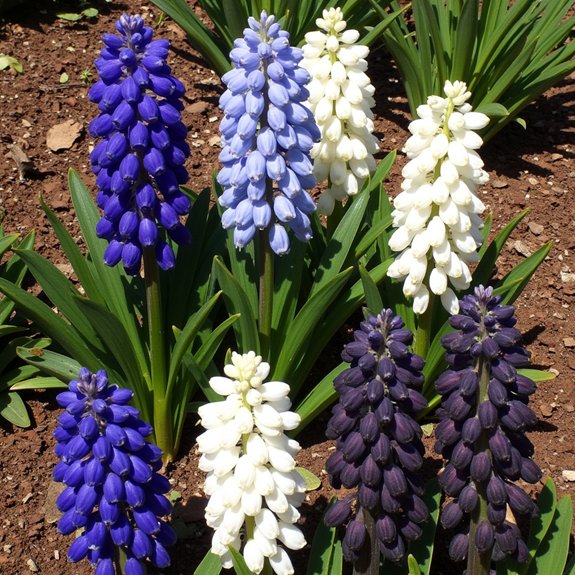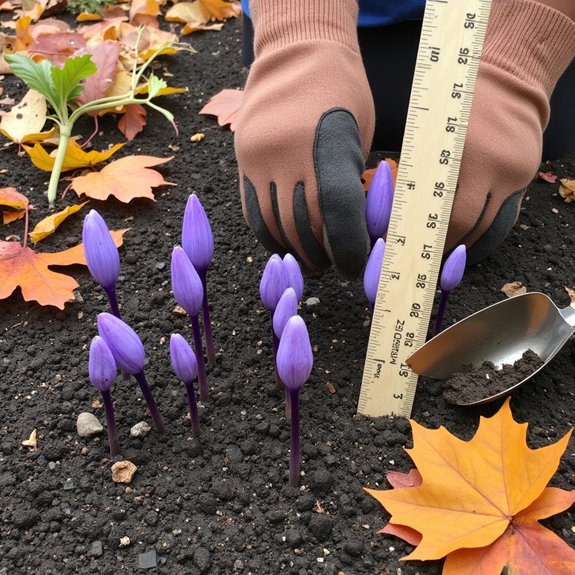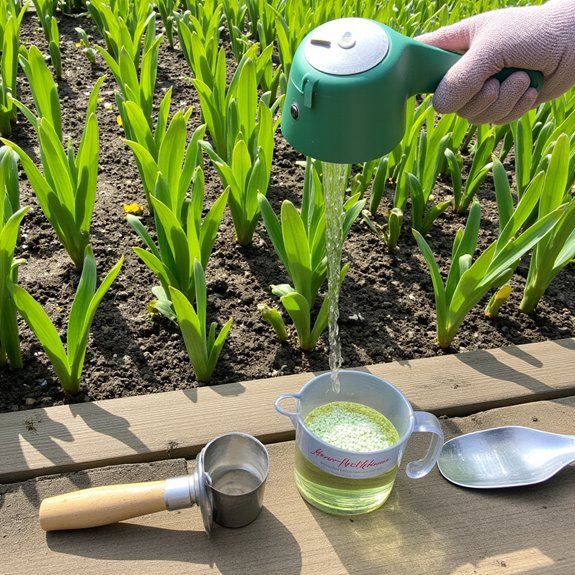Grape hyacinths might look delicate, but they’re surprisingly tough performers that’ll reward gardeners with months of reliable blooms. These compact powerhouses pack serious visual punch when planted correctly, transforming ordinary spring landscapes into vibrant displays that neighbors can’t ignore. Most gardeners make critical mistakes during the initial setup phase, however, which explains why their bulbs often fail to multiply or produce those coveted dense flower clusters that make grape hyacinths so striking.
Contents
- 1 Understanding Grape Hyacinth Varieties and Characteristics
- 2 Propagation Methods: Seeds vs. Bulb Division
- 3 Optimal Planting Timing and Techniques
- 4 Sunlight, Soil, and Climate Requirements
- 5 Watering and Fertilizing Best Practices
- 6 Seasonal Maintenance and Pruning Guidelines
- 7 Landscape Design and Culinary Applications
Understanding Grape Hyacinth Varieties and Characteristics

Versatility defines the grape hyacinth family, with over 40 species offering gardeners an impressive range of options for spring color. Each variety brings distinct characteristics, from traditional blue clusters to striking white, pink, and purple blooms. The genus Muscari showcases remarkable color variations that can transform any garden space.
These bulbous perennials share common traits: compact size, grape-like flower clusters, and exceptional cold-hardiness. Most varieties reach 6-8 inches tall, making them perfect for borders, rock gardens, or naturalizing in lawns. Their consistent blooming habit and self-seeding nature guarantee reliable spring displays year after year.
Propagation Methods: Seeds vs. Bulb Division
When it comes to expanding grape hyacinth collections, gardeners can choose between two proven propagation methods: growing from seeds or dividing existing bulbs. Seed harvesting begins in summer after pods dry completely, requiring refrigeration stratification to mimic winter conditions. This method takes longer but produces numerous plants.
Bulb division offers quicker results, best performed during late spring or early fall dormancy. Carefully separate offset bulbs from parent plants. Proper bulb storage in cool, dry locations preserves viability until planting time.
Both methods succeed with proper timing, though division guarantees faster blooms the following season.
Optimal Planting Timing and Techniques

Since timing determines success more than technique, grape hyacinth bulbs perform best when planted during late fall, before the ground freezes solid. This timing allows bulbs to establish roots before winter dormancy kicks in.
Proper planting depth matters greatly, with bulbs needing 3-inch deep holes for ideal growth. Don’t plant too shallow, or they’ll struggle with temperature fluctuations. Spacing guidelines recommend 3-4 inches between bulbs, giving each one room to multiply naturally.
After placing bulbs pointy-side up, water thoroughly once, then step back. Avoid creating soggy conditions that lead to rot, and you’ll see spring blooms.
Sunlight, Soil, and Climate Requirements
Grape hyacinths demand 6-8 hours of direct sunlight daily for peak performance, though they’ll tolerate partial shade in hotter regions. East-facing locations work perfectly, capturing morning light while avoiding harsh afternoon heat.
Proper soil drainage ranks as the most critical factor for success. These bulbs rot quickly in soggy conditions, so heavy clay soils need sand or fine gravel mixed in. Sandy soils drain naturally but require more frequent watering.
Climate-wise, they thrive in USDA zones 4-8, with some varieties pushing into zones 3-9. Cooler winters actually promote better spring blooming, while consistently warm winters can reduce flower production considerably.
Watering and Fertilizing Best Practices

Although these hardy bulbs tolerate drought once established, they’ll reward gardeners with stronger blooms when watered consistently. Weekly watering works perfectly for garden beds, but container plants need attention two to three times weekly during hot weather. The key lies in maintaining steady moisture without creating soggy conditions that cause bulb rot.
Watering frequency should decrease after blooms fade, allowing foliage to photosynthesize naturally. Regarding fertilizer types, grape hyacinths don’t require feeding at planting since they naturalize easily. However, container gardeners can apply bulb fertilizer to replenish nutrients depleted from confined soil.
Seasonal Maintenance and Pruning Guidelines
Beyond proper watering and feeding, these spring bloomers need minimal seasonal care throughout the year. The key pruning techniques involve waiting until after flowering ends, then cutting spent flower stems with sharp scissors. However, don’t touch the foliage yet. Those green leaves must photosynthesize for 6-8 weeks to fuel next year’s blooms. Once foliage yellows naturally, cut stems to ground level. Summer requires no attention, while fall brings bulb division opportunities. This seasonal care routine keeps grape hyacinths healthy and prevents overcrowding. Remember, patience with dying foliage pays off with spectacular spring displays.
Landscape Design and Culinary Applications
When spring gardening meets the kitchen, grape hyacinths offer dual-purpose appeal that’s often overlooked. Their landscape aesthetics shine when planted in masses, creating stunning carpet effects across garden beds. Dense groupings of 25-50 bulbs produce the most dramatic visual impact.
Beyond beauty, these flowers provide culinary uses that Mediterranean cooks have enjoyed for centuries. The bulbs, buds, and flowers are all edible when properly prepared. Raw blooms taste bitter due to saponins, but cooking eliminates this issue. Sauté buds with olive oil for unique spring dishes, or pickle unopened flower clusters for tangy garnishes.
